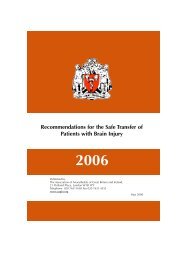TheatrePracticeStandardsGeneric1
Create successful ePaper yourself
Turn your PDF publications into a flip-book with our unique Google optimized e-Paper software.
SECTION X - RESOURCE IMPLICATIONS FOR T R A N S F E R<br />
OF PATIENTS WITH BRAIN INJURIES<br />
Without adequate resources it is not possible to have a good quality<br />
transfer service. Each organisation that provides acute healthcare<br />
should recognise that this requires specific funding which should be<br />
considered in discussions with purchasers. Resources include staff and<br />
equipment that may be similar to, and shared with, those used for other<br />
secondary transfers including the movement of ICU patients within the<br />
hospital. It should be recognised that there are significant resource<br />
implications to the transferring hospital on-call anaesthetic team.<br />
Hospitals involved in transfer of patients with brain injuries should set<br />
aside a budget for this work. The budget will include the capital<br />
equipment, the cost of which will depend upon its complexity and the<br />
demand placed upon it, as well as the cost of servicing, maintenance,<br />
insurance and renewal/upgrading at appropriate intervals. Portable<br />
equipment will need regular battery replacement and will have a<br />
shorter life than static equipment. There must be adequate provision for<br />
clothing and personal insurance.<br />
The responsibilities of the designated consultant for transfers include<br />
logistics, training, audit and liaison between the parties involved and<br />
may require dedicated programmed activities in job plans. Rotas of<br />
doctors and nurses must take account of this work and allow staff of<br />
adequate seniority to be released from other duties.<br />
Retrieval teams have been set up in some regions eg Northern Ireland<br />
[21] and are of particular importance in paediatric practice.[22]<br />
However, the speed of transfer required for head injuries may not<br />
permit a team to travel from the neuroscience centre. In addition, on<br />
a rare occasion two transfers may be required simultaneously, hence<br />
the referring hospitals will have to maintain the capability to transfer<br />
transfer patients with a time-critical lesion. This means that any unit<br />
potentially admitting children with head trauma should have a<br />
contingency to undertake such a transfer and have an appropriate kit<br />
with paediatric equipment ready for use. In an ideal world the funding<br />
of suitably situated retrieval teams would not be an issue.<br />
17





